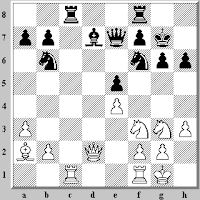Opening 
The objectives in the opening are to develop the pieces and to get the King into safety. Since there are eight pieces in the initial position, their development takes eight moves. Adding two Pawn moves to let out the line pieces (Bishops, Rooks, and Queen) gives a minimum of ten moves for development.
In the diagram, White has used the first eight moves to move four Pawns and develop all four minor pieces. Black has used the first seven moves to move three Pawns, develop three minor pieces, and castle.
The White pieces generally have a small advantage in the opening, since they move first.
Middle game

Both players have made another 13 moves. The material is still equal, but Black has a small weakness on a7/b6 which White will exploit. The next few moves will focus on this weakness.
The middle game is the phase where the creativity of both players takes hold. It is also the phase where most games are won and lost.
Endgame
White has managed to win a Pawn on the queenside. Although there are many difficulties to overcome, White has a winning position.
White will now try to advance the a-Pawn to a8, where Black will have the choice between letting the Pawn promote to a Queen or sacrificing the Rook for the Pawn. In either case White's material advantage will be sufficient to win the game easily.

The objectives in the opening are to develop the pieces and to get the King into safety. Since there are eight pieces in the initial position, their development takes eight moves. Adding two Pawn moves to let out the line pieces (Bishops, Rooks, and Queen) gives a minimum of ten moves for development.
In the diagram, White has used the first eight moves to move four Pawns and develop all four minor pieces. Black has used the first seven moves to move three Pawns, develop three minor pieces, and castle.
The White pieces generally have a small advantage in the opening, since they move first.
Middle game

Both players have made another 13 moves. The material is still equal, but Black has a small weakness on a7/b6 which White will exploit. The next few moves will focus on this weakness.
The middle game is the phase where the creativity of both players takes hold. It is also the phase where most games are won and lost.
Endgame

White has managed to win a Pawn on the queenside. Although there are many difficulties to overcome, White has a winning position.
White will now try to advance the a-Pawn to a8, where Black will have the choice between letting the Pawn promote to a Queen or sacrificing the Rook for the Pawn. In either case White's material advantage will be sufficient to win the game easily.

